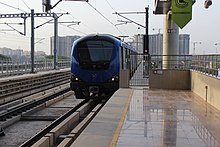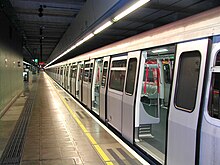Urban rail transit
This article needs additional citations for verification. (July 2010) |

Urban rail transit is an all-encompassing term for various types of local rail systems providing passenger service within and around urban or suburban areas. The set of urban rail systems can be roughly subdivided into the following categories, which sometimes overlap because some systems or lines have aspects of multiple types.
Urban rail transit types[]
Tram[]

A tram, streetcar, or trolley system is a rail-based transit system that runs mainly or completely along streets (i.e. with street running), with a relatively low capacity and frequent stops. Passengers usually board at street- or curb-level, although low-floor trams may allow level boarding. Longer-distance lines are called interurbans or radial railways. Few interurbans remain, most having been upgraded to commuter rail or light rail, or else abandoned.
The term "tram" is used in most parts of the world. In North America, these systems are referred to as "streetcar" or "trolley" systems; in Germany, such systems are called "Straßenbahn" which literally translates as "street train" or "street railway".
Updated tram systems have higher passenger capacities than traditional streetcars.
Light rail[]
A light rail system is a rail-based transit system that has higher capacity and speed than a tram, usually by operating in an exclusive right-of-way separated from automobile traffic, but which is not (as rapid transit is) fully grade-separated from other traffic. Light rail also generally operates with multiple units trains rather than single tramcars. It emerged as an evolution of trams/streetcars. Light rail systems vary significantly in terms of speed and capacity. They range from slightly improved tram systems to systems that are essentially rapid transit but with some level crossings.
The term "light rail" is the most common term used, though German systems are called "Stadtbahn" (which translates to "city railway").

Rapid transit[]

A rapid transit system is a railway—usually in an urban area—with high passenger capacities and frequency of service, and (usually) full grade separation from other traffic (including other rail traffic). It is often known as "heavy rail" to distinguish it from light rail and bus rapid transit.
In most parts of the world, these systems are known as a "metro" which is short for "metropolitan". The term "subway" is used in many American systems, as well as in Glasgow and Toronto. The system in London is named the "Underground" and commonly nicknamed the "tube". Systems in Germany are called "U-Bahn", which stands for "Untergrundbahn" (underground track). Many systems in East, Southeast and South Asia such as Taipei, Chennai and Singapore are called "MRT" which stands for "mass rapid transit". Systems which are predominantly elevated may be referred to as "L" as in Chicago or "Skytrain", as in Bangkok and Vancouver. Other less common names include "T-bane" (in Scandinavia) and "MTR".
Monorail[]
A monorail is a railway in which the track consists of a single rail, as opposed to the traditional track with two parallel rails.
Commuter rail[]

A commuter rail, regional rail, or suburban rail system operates on mainline trackage which may be shared with intercity rail and freight trains. Systems tend to operate at lower frequencies than rapid transit or light rail systems but tend to travel at higher speeds, have more widely spaced stations, and cover longer overall distances. They have high passenger capacities per a single train.
Though many European and East Asian commuter rail systems operate with frequencies and rolling stock similar to that of rapid transit, they do not qualify as such because they share tracks with intercity/freight trains or have at grade crossings. For example, S-trains are hybrid systems combining the characteristics of rapid transit and commuter rail systems. Generally, S-trains share tracks with mainline passenger and freight trains, but distances between stations and service headway resemble Metro systems.
AGT[]
The systems tend to operate with medium passenger capacities.
Funicular[]
A funicular is a cable-driven inclined railway that uses the weight of descending cars to help pull the ascending cars up the slope.
Cable car[]
A cable car in the context of mass transit is a system using rail cars that are hauled by a continuously moving cable running at a constant speed. Individual cars stop and start by releasing and gripping this cable as required. Cable cars are distinct from funiculars (where the cars are permanently attached to the cable) and cable railways (which are similar to funiculars, but the rail vehicles are attached and detached manually).
Classification issues[]

Transit agencies' names for lines do not necessarily reflect their technical categorization. For example, Boston's Green Line is referred to as a subway, despite being mostly made up of above-ground portions. Conversely, the Docklands Light Railway in London, Green Line in Los Angeles, and some metro lines in China are referred to as "Light Rail" even though they qualify as rapid transit because they are fully grade-separated and provide a high frequency of service.
Many cities use names such as subway and elevated railway to describe their entire systems, even when they combine both methods of operation. Slightly less than half of the London Underground's tracks, for example, are actually underground; New York City's subway also combines elevated and subterranean stations, while the Chicago 'L' and Vancouver SkyTrain use tunnels to run through central areas.
Other types of services[]
Guided bus[]
A bus shares many characteristics with light rail and trams but does not run on rails. Trolleybuses are buses that are powered from overhead wires. Vehicles that can travel both on rails and on roads have been tried experimentally, but are not in common use. The term bus rapid transit is used to refer to various methods of providing faster bus services and the systems which use it have similar characteristics to light rail. Guided buses are buses capable of being steered by external means, usually on a dedicated track or roll way that excludes other traffic. Some cities experimenting with guided bus technologies, such as Nancy, have chosen to refer to them as 'trams on tires' ( rubber-tired trams) and given them tram-like appearances.
Economics of rail transit[]

The examples and perspective in this article may not represent a worldwide view of the subject. (December 2010) |
In a 2006 article, political scientist Ted Balaker and urban planner Cecilia Juong Kim say that public rail transit provides certain benefits for a community, but also that the goals of policymakers are not often met. They also say some American economists claim that, contrary to popular belief, rail transit has failed to improve the environment, serve the poor, or reduce highway congestion in the United States. They also say economists are somewhat more optimistic about rail transit's impact on economic development.[1]
See also[]
- Passenger rail terminology
- List of tram and light rail transit systems
- List of town tramway systems
- Streetcars in North America
- List of North American light rail systems by ridership
- Medium-capacity rail system
- List of premetro systems
- List of metro systems
- List of automated train systems
- List of North American rapid transit systems by ridership
- List of rail transit systems in North America
- List of monorail systems
- List of suburban and commuter rail systems
- List of United States commuter rail systems by ridership
- List of funicular railways
- List of bus rapid transit systems
- List of United States local bus agencies by ridership
- List of trolleybus systems
- List of airport people mover systems
- Lists of rapid transit systems
References[]
- ^ Balaker, Ted; Kim, Cecilia Juong (September 2006). "Do Economists Reach a Conclusion On Rail Transit?". Econ Journal Watch. 3 (3): 551–602. Retrieved August 12, 2014.
Further reading[]
- "Electric Railway Transportation", Annals of the American Academy of Political and Social Science (January 1911) 37 (1): 1–202 – 17 articles by experts in 1911.
| Wikivoyage has a travel guide for Urban rail. |
- Electric rail transport
- Light rail
- Passenger rail transport
- Rapid transit